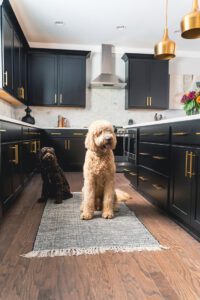Including your four-legged friends in your home design.


Today, homeowners’ fur-buddies’ needs have garnered a top spot on renovation or new-build project wish lists. Despite owners wanting to make pets comfortable in their abodes, a priority remains to keep homes odor and hair free, and without the clutter that comes with a surplus of toys or pet items.
“In my project questionnaire, I try to keep the pets in mind and design around the wants and needs of my clients,” says Atlanta-based designer Amber Guyton of Blessed Little Bungalow. “I do not want them to think of having [cats and dogs] as a restriction, so we have the conversation [about them].”
Durable Selections
When selecting flooring, countertops and upholstery or rug fabrics, Guyton considers sturdy, low maintenance and performance materials. Some fabric examples include wool, velvet, canvas, leather and microfiber that can do better with potential stains, nails and hair.
While some people may be wary of choosing a leather sofa in a home with an animal because of scratching, options that offer the look but are more durable include a patterned weave or wipeable faux leather. In lieu of hardwood flooring, vinyl planks and tile are not as easily damaged by wear and tear.
Design Ideas
Guyton created a “dog room” under her stairs with a gate for ventilation for her 15-year-old dachshund, Ralph. She says although he is free to sleep on her furniture, this solution is a great way to tuck away his toys and to crate him when she is not at home.
An option to hide the cat litter box: Put it inside a vanity with an opening in a secondary bath or on a “catio,” a cat patio that gives kitties a taste of the great outdoors safely.
Custom kitchen cabinets also can provide seamless places to store pet food. “I have seen lower cabinet pullouts for food and water bowls, as opposed to having them on the floor, which is easier for cleanup and less hazardous to foot traffic,” Guyton says. “Depending on a client’s budget and how many square feet they can spare, they can also include bathing stations and/or sleeping quarters in a new home or renovation.”
Realistic Expectations
The designer says clients need to be realistic about what will work with a pet at home and what will not. You’re better off with materials and furniture that do not have to be replaced every few years. For a truly pet-friendly space, there may be some things you have to go without, but you can still have a home that is comfortable, livable and perfect for the whole family.
BLESSED LITTLE BUNGALOW
blessedlittlebungalow.com
@blessedlittlebungalow
Pets columnist at Simply Buckhead. Professional writer and editor. Proud animal rescue volunteer.




